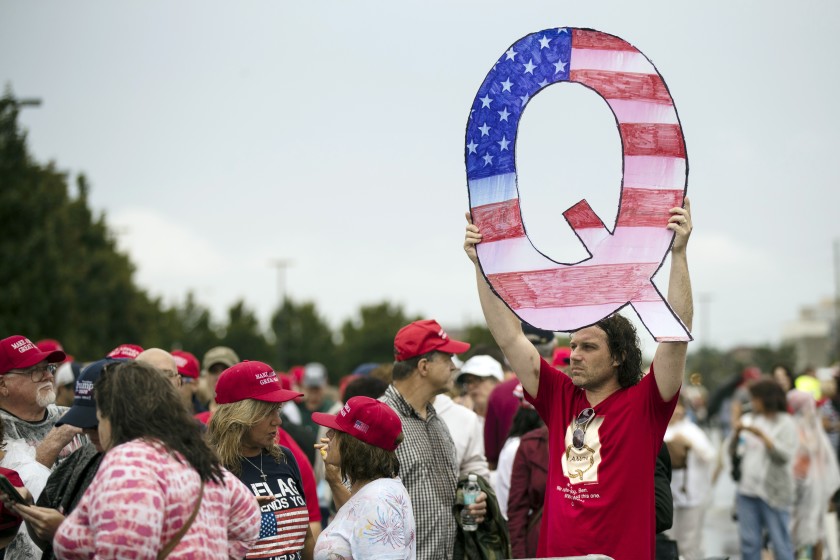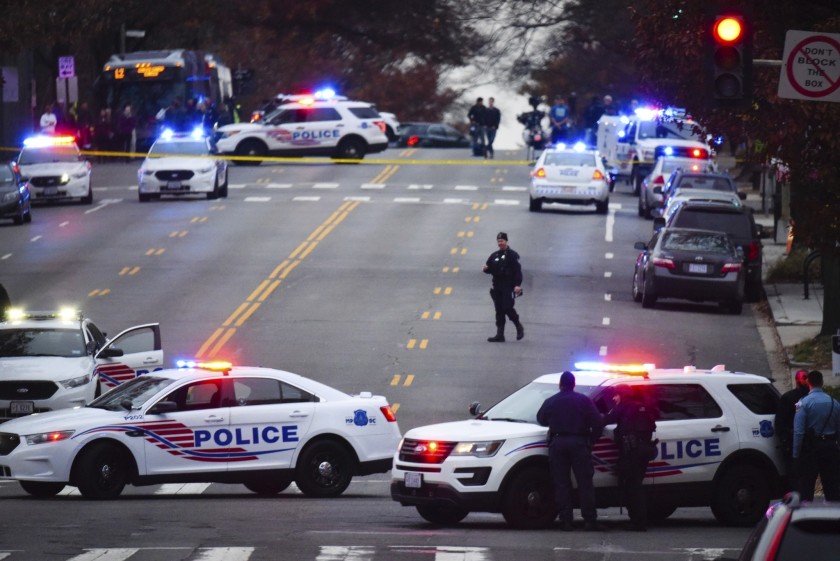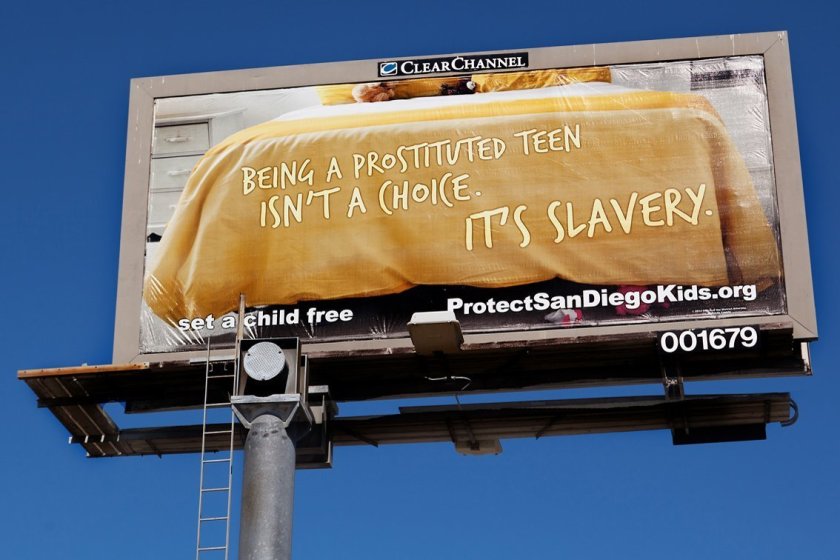Experts worry QAnon conspiracies are overshadowing fight against child trafficking
Rallying in the center of Santee’s busy shopping district on a recent Saturday, men, women and children waved signs condemning the sexual exploitation of children.
“Standing 4 children” read one, and “End human trafficking” another. They received honks of support as drivers passed by.
There were other signs, though, that raised fears among some child-victim advocates that their long-standing efforts to fight trafficking are being hijacked and radically politicized by backers of conspiracy theories.
The Santee rally included hand-lettered support for “WWG1 WGA,” an abbreviated version of the slogan “Where we go one, we go all,” adopted by those who ascribe to the belief system known as QAnon.
One man carried the message: “FBI FBI FBI. INVESTIGATE PIZZA-GATE,” a nod to the debunked conspiracy theory that powerful Democrats were running a child sex-trafficking ring out of a Washington pizza parlor.
And another: “#PIZZAGATE IS REAL. SAVE OUR CHILDREN.”
Similar protests have played out on street corners across the country and other parts of the globe in recent weeks, including another one in downtown San Diego organized by a different group.
The rallies were in response to calls to action that have spread virally through social media hashtags such as #SaveTheChildren, #SaveOurChildren and #Wheresthechildren.
While the front-facing message of the hashtag campaign confronts the all-too-real horrors of children being sold for sex and pedophilia, many of the ideas it promotes are rooted in conspiracy theories at the center of QAnon.

A man holds a Q sign while waiting with others to enter a campaign rally with President Donald Trump in Wilkes-Barre, Pa.
(ASSOCIATED PRESS)
Advocates for child victims have been working for years to expand public awareness surrounding sexual exploitation and trafficking, but the narrative that is being constructed around the latest viral movement has many of them worried.
Sensational depictions of random kidnappings, coupled with inflated and unreliable data, undercuts the efforts already underway and distorts public perceptions of the reality of trafficking, experts said.
“I am troubled by the misinformation that is blended with true concern,” said Jamie Gates, a professor at Point Loma Nazarene University who co-authored a study examining the scope of sex trafficking in San Diego County.
One of QAnon’s core tenets is the belief that President Donald Trump is fighting a military-backed holy war against a secretive ring of satanic elites who sexually exploit children, and sometimes eat them, while being protected by a “deep state” global bureaucracy.
Hollywood A-listers and Democrats are seen as the villains in the baseless conspiracy theory. The FBI in Phoenix last year characterized QAnon as a domestic terror threat after linking it with acts of violence.
The complex and sprawling ideology stems from the online postings of an anonymous figure, “Q,” who claims to be a government insider with access to classified information. QAnon conspiracies have also branched into several other directions, from the faked death of John F. Kennedy Jr. to “deep state” coup plots.
Support for QAnon has broadened recently to include GOP candidates for Congress, and the President has further bolstered the group’s profile by re-tweeting followers and positively acknowledging the cause.
Now the crusade against pedophilia has found a foothold with a wider audience, and the line between protesting the crime of child exploitation and advancing QAnon doctrine is blurry.
Content on social media platforms associated with the hashtag #SaveOurChildren, for example, can include straightforward memes abhorring sex trafficking and often contains links to mainstream news reports of arrests or police investigations. But with a few clicks, the hashtag can also send users down a rabbit hole.
Engagement with #SaveOurChildren on Facebook and Instagram was strongest with QAnon-related accounts in August, according to an analysis by the nonprofit First Draft, as reported by NBC News.
The issue of child sexual exploitation makes for an easy entry point into the more implausible ideologies linked to QAnon, said Whitney Phillips, an assistant professor at Syracuse University who teaches media literacy, mis- and disinformation and political communication.
Actual trafficking cases, such as the wide-ranging allegations against wealthy financier Jeffrey Epstein, sometimes fit neatly into QAnon’s overall narrative, lending coherence to many of the other claims that seem more outrageous on their own.
“When you lend credence to one element of the QAnon narrative, more people are likely to buy into the more destructive elements of that narrative,” said Phillips, who explores similar themes in her new book “You Are Here: A Field Guide for Navigating Polarized Speech, Conspiracy Theories, and Our Polluted Media Landscape.”
“You aren’t able to separate out an actual datapoint from the speculative stuff that gets all squished together,” she said.

Police secure the scene near Comet Ping Pong in Washington, D.C., on Dec. 4, 2016. A North Carolina man fired an assault rifle inside the pizzeria, claiming he was investigating the Pizzagate conspiracy theory.
(Sarah L. Voisin / AP)
Taking to the streets
Many of the rallies, including those locally, don’t claim QAnon alliances and instead promote inclusivity and unity aimed at a common cause — protecting children.
“We are an apolitical and non denominational movement,” read the Facebook event details for the Aug. 22 Freedom for the Children Walk in Santee. “We are accepting of all religious/spiritual denominations, political affiliations, races and orientations. In order to create unity, we ask that people involved in this movement set their differences aside and focus on the current goal.”
Conspiracy theories popular with QAnon were openly displayed on signs at the event. On the event’s page, an organizer posted a link to a video — “PEDOGATE 2020 Pt.3 – Symbolism & Pizzagate 2.0” — that has since been removed from YouTube for violating its rules.
Organizer Bobby Nothwang described the link as “an in-depth investigation video I came across, an informational awareness thing showing how deep this goes.” But he stressed the video and signage were expressions of various personal beliefs and were not affiliated with the Freedom for the Children group.
Jaime Norris-Ross, who helped organize a separate protest on Aug. 29 at the Star of India downtown, said she had been on social media one day when she happened across the #WheresOurChildren hashtag.
“It scared me because I didn’t realize how bad it was until I dove into it,” the 43-year-old Ramona resident said.
She connected with the newly formed Tennessee-based group Where’s Our Children and agreed to host a march. She was given clear instructions to stress the apolitical nature of the event.
“I liked it because their whole thing is we’re not supporting a party, we’re trying to bring people together in a time of such divide,” Norris-Ross said. “Let’s try to focus on something more positive about our children and making people more aware.”
Norris-Ross is a Republican. Her co-host, Michelle Carr, 51, of Ramona is a Democrat and survivor of childhood sexual abuse.
“I’m speaking up for children who do not have a voice because nobody stood up for me. I had to do it all on my own,” said Carr, who expressed special concern for at-risk foster youth and children in abusive homes who are trapped due to the pandemic.
Some of the participants, when asked for their views, shared talking points popular with QAnon.
“Hollywood you afraid yet?” asked one sign, held by Ashley Solano, 30. The question was accompanied by smeared handprints that have come to symbolize the cause.
“I believe it’s a lot of powerful people in Hollywood and politicians who are involved in this, and it’s a huge sex-trafficking ring,” the Vista resident told the Union-Tribune. “That’s what I really believe. They’re taking our children and breeding them. There’s a lot to it. We could be here for hours talking about it.”
Jasleen Nelson, 59, of Alpine spoke of her belief of a massive cover-up among powerful figures.
“I have a problem with Hollywood and pedophilia and all the underground tunnels around the world and the satanic sacrifices and baby food, that they’re eating children,” said Nelson, who attended the rally after hearing about it on Facebook. “I mean, it’s got to get out. They all know about it, but they just don’t talk about it because it’s all their friends, and they don’t want to turn their friends in. It’s time everybody woke up. And I think Trump’s going to do that, and he’s doing that.”
When asked about the QAnon-type beliefs some of the event’s participants held, organizer Norris-Ross acknowledged “you are going to come across that kind of stuff.”
“I’m not a QAnon person,” she elaborated. “I’m not going to say whether it’s right or wrong. We welcome everybody.”
Husband John Ross, a police officer with the San Diego Unified School District who co-hosted the rally, said Facebook has taken down certain pages relating to the effort. The action comes around the same time Facebook announced it was cracking down on QAnon-related content and blocking #SaveTheChildren, which shares the name of an unaffiliated humanitarian organization, Save The Children.
“Facebook has censored some Save Our Children pages, Where’s Our Children pages. We don’t know why,” Ross said.
“They say there’s not enough facts, and then they pull my posts down.”

An anti-sex trafficking billboard being displayed around San Diego County in 2014.
(Courtesy: District Attorney’s Office)
Myth vs. reality
Experts who work in the anti-trafficking field say the hashtag-inspired movement is perpetuating common myths about sexual exploitation and preys on fear with exaggerated and out-of-context statistics.
For example, a widely circulated meme associated with the trafficking hashtags asserts that 800,000 children in the U.S. disappear each year.
The figure appears to trace back to a 2002 Department of Justice study that looked at missing children reports from 1999. Of the nearly 800,000 reported to law enforcement as missing, about 115 were estimated to be victims of stereotypical kidnapping by a stranger or slight acquaintance. The vast majority of incidents were considered to be runaways or kids who went missing for “benign” reasons, such as miscommunication with their caretakers.
Updated figures show 421,394 missing-child incidents were reported to the FBI in 2019. A child who runs away multiple times would be counted separately for each incident, according to the National Center for Mission and Exploited Children, the national clearinghouse for missing children. About 91 percent are estimated to be runaways.
Most missing children are recovered quickly, according to NCMEC.
Of the nearly 26,300 runaways reported to NCMEC last year, 1 in 6 were likely victims of sex trafficking, the nonprofit estimates.
Many online rumors and memes have pushed a kidnapped-into-sex slavery narrative, but the picture does not match up with general reality in the U.S., according to Polaris Project, a nonprofit that runs the National Human Trafficking Hotline.
“Awareness based on wrong premises could lead to a general misunderstanding of what human trafficking actually is, and that means less help for victims or potential victims who need it,” said Rafael Flores, a spokesman for Polaris.
The kidnapping fear has been furthered by a recent meme that alleges traffickers were targeting child victims by tagging cars. The viral photo shows the markings “1f1b,” which the poster assumes to mean “one female” and “one boy” or “one baby.” Online fact-checker Snopes has debunked the theory.
Polaris has felt the direct impact of such conspiracy theories. Callers have inundated the hotline with reports that mimic information circulating online, including a recent one that falsely alleged that online retailer Wayfair was trafficking children. The call volume has at times overwhelmed the hotline’s services meant for victims and survivors, Flores said.
Operation Underground Railroad, a global nonprofit started by a former federal agent, urged those who are concerned about the issue to “understand what is happening through the lens of accurate information.”
“Unfortunately, in some instances, the effort to knock out child exploitation and human trafficking is being harmed by individuals and a number of conspiracy theory groups who have chosen to latch onto child exploitation and human trafficking as a vehicle to deceptively bolster their causes,” the group said on its website. “This is not welcomed, nor should it be supported.”
In reality, juveniles in the U.S. who are trafficked are most often exploited by someone they know and trust.
“Most traffickers take time to build relationships and influence within the lives of those they intend to exploit,” said Stacey Williams, the director of human trafficking prevention programs at PCI. The international humanitarian organization, based in San Diego, belongs to the San Diego Trafficking Prevention Collective and has rolled out programs in local schools to address root causes of trafficking.
For teen victims — the average entry age of victims in San Diego County is 16 years old — those relationships often start as perceived romances. Traffickers later employ tactics of fear, force and coercion to push victims into being sold for sex. While there is no specific profile of a victim, those who are fleeing abusive homes, homeless or in the foster system can be more vulnerable to exploitation, according to research.
A study by Gates and co-authored by Ami Carpenter at the University of San Diego estimates an average of 5,000 people, mostly women and youth, are victimized in the county each year.
Recruitment can happen anywhere — in schools, malls, trolley stops, within friend groups — but has increasingly moved online, even more so with the coronavirus pandemic.
Street gangs are heavily involved in the county’s sex trafficking industry, which brings in an estimated $810 million annually, according to the 2013 analysis.
The anti-trafficking movement has benefitted greatly from bipartisanship over the years — from legislation to funding to enforcement priorities to research. But movements like QAnon threaten to unravel the history of cooperation, Gates said.
“This group is radically politicizing human trafficking in a way that would demolish the levels of collaboration that we’ve been able to painstakingly construct across the aisle.”
More information
To learn more about human trafficking in San Diego County and to find ways to help, visit:
San Diego Trafficking Prevention Collective: sandiegotpc.org
District Attorney’s Office: sdcda.org/preventing/human-trafficking/
*** This article has been archived for your research. The original version from The San Diego Union-Tribune can be found here ***


